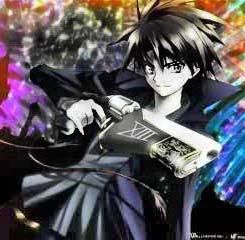|
|
Post by Ayin Tsade on Feb 23, 2009 18:09:48 GMT -4
This thread records the details on the 13 official lightsaber fighting styles of the New Jedi Order, as well as a few other minor styles. The point is to help us understand the differences in fighting techniques so that we can describe our characters and our battles with greater detail and make them even more interesting. In chronicling these lightsaber forms, I have essentially filched the information from wookiepedia and edited the information, while adding a few paragraphs myself (usually involving examples of the style being used by our own characters). ------ During the days of the Old Republic, there were only seven official forms, which were Form I: Shii-Cho - "Determination" or "Way of the Sarlacc" Form II: Makashi - "Contention" or "Way of the Ysalamiri" Form III: Soresu - "Resilience" or "Way of the Mynock" Form IV: Ataru - "Aggression" or "Way of the Hawk-Bat" Form V: Shien / Djem So - "Perseverance" or "Way of the Krayt Dragon" Form VI: Niman - "Balance” or "Way of the Rancor" Form VII: Juyo / Vaapad - "Violence" or "Way of the Vornskr" Now, the New Jedi Order recognizes several of these "substyles," such as Vaapad, as being prominent and different enough from their original variations to warrant being listed as an individual fighting form. Ayin Tsade helped define and chronicle the different fighting forms, two of which he himself invented. The 13 Lightsaber forms -- Form I: Shii-Cho - "Determination" or "Way of the Sarlacc" Form II: Makashi - "Contention" or "Way of the Ysalamiri" Form III: Soresu - "Resilience" or "Way of the Mynock" Form IV: Ataru - "Aggression" or "Way of the Hawk-Bat" Form V: Shien - "Perseverance" or "Way of the Krayt Dragon" Form VI: Djem So - "Dominance" or "Way of the Iron Grip" Form VII: Niman - "Balance” or "Way of the Rancor" Form VIII: Juyo - "Violence" or "Way of the Vornskr" Form IX: Vaapad - "Ferocity" or "Way of the Penumbra" Form X: Sokan - "Cruelty" or "Way of Awareness" Form XI: Jar'Kai - "Duality" or "Way of the Twin Blades" Form XII: Veros - “Fluidity” or “Way of the Vortex” Form XIII: Torr’en Sho - ‘Versatility” or “Way of the Maverick” (gun and saber) "I wrote [the battle sequences] very much like a game of chess played at a thousand miles an hour. And every single move is check." - Nick Gillard, choreographer for Episodes I-IIIForm I: Shii-Cho, also known as The Way of the Sarlacc, or The Determination Form, was the first of the original seven forms of lightsaber combat. "It is simple, and its simplicity is strength."
- KreiaDue to its simplicity, it was often the first form taught, so almost all lightsaber duelists included some aspect of Shii-Cho in their swordplay. One of the marks of contact, sun djem, was a goal of early Form I duelists, as disarming or destroying the opponents' weapons could ensure victory without causing injury, which was always a Jedi objective. However, with the rise of Form II, sun djem became nearly impossible as Makashi duelists were well trained to prevent their own weapons from being taken or destroyed. Form I, like its succeeding forms, included the following basic techniques and concepts: >Attack: A set of attacks aimed at different body zones. >Parry: A set of blocks to thwart any attack in the specified body zones. >Body target zones that determined the areas to strike or to block. The body zones were: 1 – Head 2 - Right arm and side 3 - Left arm and side 4 - Back 5 - Right leg 6 - Left leg >Training drills called velocities. (See below.) Form I was one of the easiest forms to learn, yet still powerful. Their (velocity) training included learning to deflect plasma bolts from training remotes while being blindfolded or covered up by a practice helmet. Lightsaber instructors such as Yoda and Cin Drallig taught Form I to thousands of students during their Jedi careers. Kit Fisto was a notable practitioner of Form I, and his proficiency in the style earned him a position among the greatest swordsmen in the Jedi Order. However, even his skill was not enough to stand against the visceral intensity of Darth Sidious. Form I was better served against multiple enemies, and one opponent as powerful as Sidious was able to find flaw in it. Obi-Wan Kenobi commented that Form I was wild, raw, and deadly, and requiring much emotional heat. Kit Fisto noted how hard it was to control the pull of Form I, disabling opponents rather than killing them. Dooku himself commented that Shii-Cho swordplay was deliberate as a lumberdroid, moving step by step, cutting off the angles, clumsy but relentlessly dogged; in his own words, "Too slow... too predictable." Shii-Cho form was most effective in situations with multiple opponents and did not offer many techniques for blocking blaster bolts or dueling one lightsaber wielding opponent. Nonetheless, Shii-Cho was an effective form to fall back on when no other form would do to suit the current combat situation. Kit Fisto’s descendant, Swil Kit Fisto, is also known to employ this style. Horizontal Parry:The lightsaber is at shoulder height with the blade almost on the shoulder. Below is Kit Fisto in the horizontal parry position. 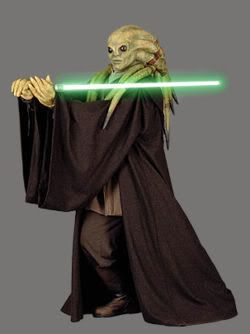 Jedi Weapon Master Ayin Tsade employed a variation of this stance during his initial battle against Tiberian in the Jedi Temple. Ayin straightened his posture while angling the blade directly at his opponent, keeping his weapon an inch away from his face in a horizontal fashion. This variation turned the Form I defensive stance into an aggressive stance, which Tsade used to challenge the Sith Lord. The stance also possesses a surprising amount of defensive capability, in that Ayin could easily block any attack directed at his front by angling his saber in different directions. The only major limitation of this fighting pose was that it is not the most mobile form; fighters in this stance tend to battle in the same location. However, it is possible that Ayin could still use his phenomenal speed to close the gap between himself and his opponent to make use of the stance. Grip:In Shii-Cho form, a lightsaber is held by putting one hand on the very top of the hilt, next to the emitter, and another hand on the pommel. On the top hand, pressure was applied to the ring and little finger, and the thumb, as if one could fight without the middle and index fingers. The bottom hand was maneuvered in a push-pulled motion, using the top hand as a fulcrum. |
|
|
|
Post by Ayin Tsade on Feb 23, 2009 18:14:45 GMT -4
Form II: Makashi, also known as The Way of the Ysalamiri, or The Contention Form, was the second form of the original seven forms of lightsaber combat. "He is a fencer. Leverage, position, advantage—they are as natural to him as breathing."- Qui-Gon Jinn's spirit to Yoda on Count Dooku "Form II, also called Makashi, represents the ultimate refinement of lightsaber-to-lightsaber combat."- Cin Drallig on Form II After Form I's proliferation as a lightsaber combat technique, Form II came about as a means of lightsaber-to-lightsaber combat. It was described as being very elegant, powerful, and requiring extreme precision, allowing the user to attack and defend with minimal effort, while his opponent tires himself out, often wielding the blade one-handed for greater range of movement and fluidity. The form relied on parries, thrusts, and small, precise cuts—as opposed to the blocking and slashing of the other forms. It also emphasized on the use of fluid motions and the anticipation of a weapon being swung at its target, and so the form required very fluid movements of both the blade and the body Form II countered sun djem, the goal of early Form I masters, by being well trained in prevention of disarming and weapon destruction. Feints would also be commonly used to confuse or set-up their opponents for a trap, a tactic that Darth Tyranus commonly used in his duels during the Clone Wars. The blade manipulation required for this form was very refined and required intense focus, such as Dooku's hurling objects at Anakin while using a one-handed bind to keep Obi-Wan at bay. Timing, accuracy, and skill, rather than strength, were relied on to defeat one's opponent, and with a skilled practitioner, the results were extremely potent. Precise footwork and movements were required for maintaining proper distance from the opponent during defense and/or when moving in for an attack. The footwork of Makashi practitioners followed a single line, front and back, shifting the feet to keep in perfect balance as the practitioner attacked and retreated. Makashi was a style based on balance, on back-and-forth charges, thrusts, and sudden retreats. Elegance, gallantry, enchantment, finesse, artfulness, and economy were the core of Makashi. Dooku displayed this to the extreme during the duel aboard the Invisible Hand, using his footwork to evade Anakin and Obi-Wan so that he could fight them one-on-one instead of at the same time. Makashi duelists also trained themselves to avoid enslavement to form, as such enslavement opened the practitioner to be defeated by predictability and the unforeseen. Makashi users were often elegant, precise, calm, and confident to the point of arrogance (as befit Dooku's personality). Form II users were supremely confident in their chances for victory, and often looked so relaxed when they were fighting they even appeared to be dancing. Despite its effectiveness, Form II was not without its weaknesses. Among the first of these was the fact that it was somewhat harder to deflect blaster shots with this style. Makashi was developed before blasters had become common place in the galaxy, and Form II training taught its practitioners to defend solely against blades. Skilled users could overcome this obstacle with minimal effort, however. Another drawback was that Makashi was most potent when used against a single opponent, and therefore was reduced in strength when fighting groups of adversaries. Exceptionally skilled users could still fare very well against multiple foes, however. Dooku, for example, could fight up to four adversaries at once with little difficulty. Others, such as Asajj Ventress, compensated for this difficulty by wielding multiple blades. But the greatest flaw with this system of combat was that it could not withstand strikes from later styles, which emphasized power as opposed to the elegance and precision Makashi specialized in. As shown during Dooku's fatal duel with Anakin, Makashi simply did not generate the necessary kinetic energy to meet Skywalker's preferred form, Djem So, on an even footing. The sheer, raw power of Form V wore down Dooku's defenses, physically exhausting him and draining his reserves of Force power. Opening Stance:The opening stance to Makashi is a single handed low guard. The saber would be held in the strong hand of the user, and held at his side, the blade pointed down, and the feet would be shoulder width apart. Some faced their opponent side on, so the blade was pointed in their direction. The lightsaber hilt would be held with the thumb pointing down the length of the blade to allow for smaller, tighter, more accurate movements of the saber. The rest of the fingers wrap around the hilt holding it tightly, but not so tight as to limit the fluidity of the movements. 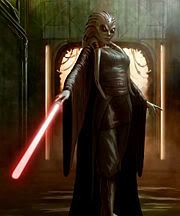 An Unidentified Nautolan Force-user in the opening stance of Form II. Makashi Salute:The Makashi salute was not an attack or maneuver but a challenge to an opponent. The saber was held in one hand, brought up vertical directly in front of the practitioner's face, then swung down and made a rapid X in the air. One of the best examples of this ancient tradition was when Count Dooku was fighting his former master Yoda at the Battle of Geonosis. Lightsaber Design Variations: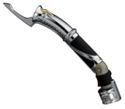 Darth Tyranus' lightsaber. "It feels strange."- Darth Bane referring to a curved-lightsaber, a weapon heavily favored by Makashi practitioners. Due to Form II's emphasis on blade manipulation, and its many fluid one-handed moves, Makashi practitioners sometimes wielded lightsabers with curved hilts. In addition to this, they are often highly decorated and occasionally include blade-guards, as shown with Dooku's lightsaber.
|
|
|
|
Post by Ayin Tsade on Feb 23, 2009 18:18:07 GMT -4
Form III: Soresu, also known as the Way of the Mynock, or The Resilience Form, was the third of the seven forms of lightsaber combat that was recognized by the Jedi Council prior to and during the Clone Wars. 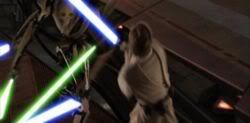 Obi-Wan utilizing Form III in his duel against General Grievous. "That is so like you, Master Kenobi. I am called a great swordsman because I invented a lethal style; but who is greater, the creator of a killing form—or the master of the classic form?"―Mace Windu to Obi-Wan Kenobi Philosophy:"Form three allows you to parry incoming attacks with minimal effort. Your opponent must expend precious energy with each blow, slowly tiring while you remain fresh and strong." ―Darth Bane to Darth Zannah The philosophy of Soresu was described as "being within the eye of the storm." The practitioner maintained a centered frame of concentration, undisrupted by the conflict around them. They did this to maintain the calm center where the outer storm of combat could not harm them. Thus, Soresu commanded powerful defensive techniques that seemed to adapt to almost any circumstance, at the cost of never reaching past the figurative eye of the storm. The Soresu technique used little to none of the attack power needed by those who concentrate on the storm itself. Those who studied this style used the primarily defensive technique to wear down aggressive opponents by defending long onslaughts with minimal counter-attacking. They waited until their adversary spent most of their energy, and then employed an alternate, more aggressive attack. They waited for eventual lapses in their opponent's own defense. "Good. Do not block. Redirect. Wait for opponents to become weary or frustrated. Let them make a mistake, then seize the opening and make them pay." ―Darth Bane to Darth Zannah during her lightsaber training Soresu utilized motions that occurred very close to the body, in an attempt to achieve near-total protection and expend as little energy as possible while executing moves. Form III stressed quick reflexes and fast positional transition, in order to overcome the rapidity with which a blaster could be fired. This technique minimized the body's exposure, making a well-trained practitioner nearly invincible. Followers of Soresu preferred to remain on the defensive until their opponent left an opening that a Soresu practitioner could exploit. Observers generally described Soresu as a passive form of combat. Jedi with extreme patience and reserved personality often employed the form - in fact, during the Clone Wars, Soresu was the most commonly used lightsaber form in the Jedi Order. Jedi Master Mace Windu noted that, unlike any of the other combat styles, Soresu was not an answer to a particular type of weakness. Vaapad was an answer to Windu's inner darkness; Ataru was Yoda's answer to his limited reach and advanced age; and Djem So helped Anakin release his own powerful emotions. Toward the end of the Clone Wars, Master Windu acknowledged Obi-Wan Kenobi as "The master of Soresu." It was because of this fact that Kenobi was chosen by the Jedi High Council as the Jedi best suited to defeat General Grievous. During their duel, the Jedi Master was capable of parrying all four of Grievous's lightsabers, gradually disarming the cyborg general. Earlier, during his duel with Count Dooku aboard the Invisible Hand, Kenobi's expertise in Soresu allowed him to parry the Count's elegant Makashi strikes. Soresu was considered the consummate Jedi combat form in that it embraced a passive way of life and a literal expression of the Jedi tenet to defend rather than attack. Obi-Wan himself considered Soresu very simple, so restrained and defense-oriented that Form III was nearly passive. As a master, Obi-Wan could defend himself against any attack less than twenty strikes per second. 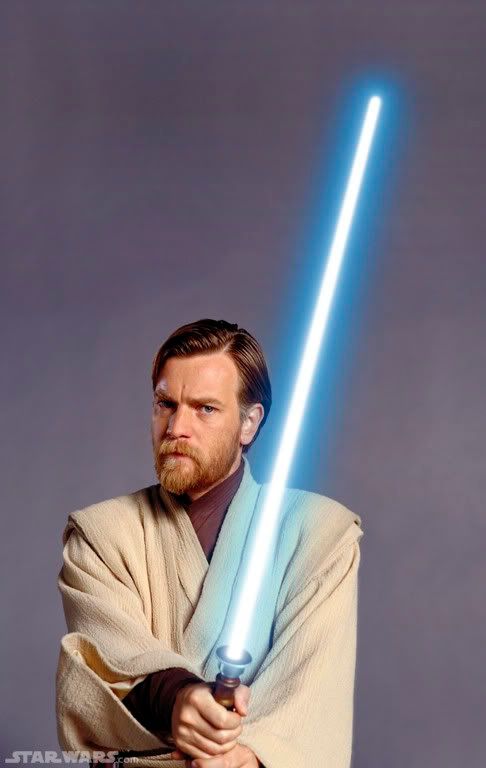 Obi-Wan's typical Soresu stance. "The smaller blades give you greater speed and maneuverability. Grip the handle lightly in your fingers. Control the weapon with your wrist and hand rather than the muscles of your arm. You will sacrifice reach and leverage, but you will be able to create a shield of impenetrable defense."―Darth Bane The defense and control it allowed a practitioner made for suitable outcomes in favor of the user when faced with hurried opponents who left themselves vulnerable to counterattack. For this reason, Jedi who mastered Soresu were known to have an unbreakable defense, and the most successful when dealing in situations when a quick victory was not as favorable as total understanding and calculated action. Also, by being more capable in lengthy battles, a Soresu user had the ability to gain control of a combat situation, allowing Jedi the choice to kill, disarm, or even reason with their opponent. 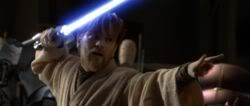 A personalized opening stance by Obi-Wan. However, its defense required a very large amount of focus from the wielder and even a momentary fault in concentration could spell defeat. Jedi with less focused minds would usually abandon this style of combat to capitalize on the benefits of other styles that required less dedication to prolonged fighting. Form III utilized strikes and blocks with the lightsaber at very fast speeds with the blade extremely close to the wielder's body. This form also utilized some acrobatics such as those seen in Form IV (Ataru) to make the wielder even harder to catch. "The road is long, but it is worth the journey, for a true master of Form Three is invincible." ―Luminara Unduli on Form Three
|
|
|
|
Post by Ayin Tsade on Feb 23, 2009 18:23:13 GMT -4
Form IV: Ataru, also known as the Way of the Hawk-Bat, or The Aggression Form, was the fourth of the seven original forms of lightsaber combat. The history of Ataru stretched back through the Old Republic, to at least as early as the Mandalorian Wars, where it was commonly employed by Jedi of that day. Ataru continued to be a common form among the Jedi in the latter stages of the Republic. An aggressive style, Form IV was fast-paced and effective against single opponents, though weaker in prolonged combat and confined spaces. Ataru was characterized by Force-assisted acrobatics, both for attack and defense, and fast, powerful strikes. Notable users of this combat form included Yoda and Qui-Gon Jinn. 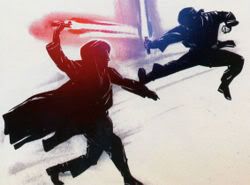 "Ataru is the name given to the movements of this form - though it is aggressive, it is focused, and its best use is in combat against a single opponent." "Ataru is the name given to the movements of this form - though it is aggressive, it is focused, and its best use is in combat against a single opponent."―Zez-Kai Ell "Form IV, also called Ataru, is the most acrobatic Form, filled with numerous elaborate moves, and relies heavily upon a Jedi's ability to run, jump, and spin using the Force." ―Cin Drallig "This form is Ataru. Because it is such an aggressive fighting style, you should only use it against single opponents." ―Vrook Lamar Ataru relied on a combination of power, strength, and speed. Practitioners of Ataru were always on the offensive, attacking with wide, fast, and powerful swings while constantly calling upon the Force to aid in their movements and attacks. By allowing the Force to flow throughout their body, they could overcome their physical limitations (including old age, as was the case with Master Yoda) and perform amazing feats of acrobatics, such as somersaults and backflips, not only for attack, but also to evade the attacks and strikes of their opponents. Jedi utilizing Ataru needed to incorporate all the Force powers that involved surpassing normal physical ranges of motion, speed, and agility in order to be successful. Running, jumping, and spinning were all emphasized in learning the elaborate kinetics of the form. Those who used Form IV could move at high speeds and could rain strong blows, jumping and attacking through the air. Powerful and quick spinning attacks could be utilized from all angles, either from ground or air. A master in Ataru combat could appear like a blur to their opponents, attacking from all directions—from the front, the sides, overhead, or behind. The Force not only allowed them to perform athletic feats not possible otherwise, but it also helped guide their actions and movements in combat. 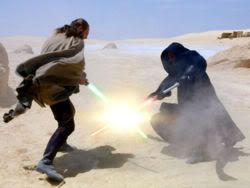 Jedi Master Qui-Gon Jinn dueling Darth Maul's Juyo style with Ataru. Ataru proved to be an effective combat form when used properly, and was common among Jedi in the Mandalorian Wars. It was well-suited to close combat, particularly against single opponents. However, because it was such an aggressive style, Ataru was not generally optimal for use against multiple opponents, and it was somewhat ineffective against blaster fire, particularly from multiple foes. Despite these weaknesses, Obi-Wan Kenobi and Qui-Gon Jinn were able to employ this form with great success during the Battle of Naboo against numerous B-1 battle droids. This form was also considered not as effective for prolonged combat, as the nature of Ataru could greatly tax the body. Fatigue was theorized to have been a contributing factor in Qui-Gon Jinn's defeat at the hands of Darth Maul. Another contributing factor in Jinn's death was the requirement of open space for the kinetic acrobatics of Ataru. Without ample space in the Theed Palace reactor core to move, Jinn was deprived of the key element in his defense, and thus could only attempt to block Maul's incessant barrage of Juyo strikes. This event influenced Kenobi—after his master's death, he changed his preferred form to Soresu, the most defensive of all forms. Through the Force, Yoda was considered to have mastered Form IV to its highest level. He used it in almost all of his battles, and his mastery of the style caused others to describe him as virtually unstoppable against most opponents, including Separatist battle droids, despite his small size and advanced age. His moves in his duel against Count Dooku on Geonosis were revealed on close examination to be a fast-paced demonstration of the standard components of Ataru, with each action flowing from one to another in the smooth transitions characteristic of Form IV. In addition, three kinds of rotation, called su ma, figured prominently in his style: jung su ma (spinning), ton su ma (somersaults), and en su ma (cartwheels). These three moves represented the three possible axes of rotation in three-dimensional space. Together with Force-enhanced jumps, the rotational su ma moves composed most of his style, making the Grand Master exemplary of Form IV mastery. At one point prior to the Clone Wars, Yoda was known to give demonstrations of the form in use, some of which were recorded on databooks in the Jedi Temple. 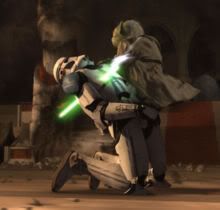 Grandmaster Yoda pwning a peon Clone Trooper. Tyranus stated that he understood "every weakness of the Ataru form, with its ridiculous acrobatics." Dooku's Makashi would counter Ataru by launching a series of thrusts toward the enemy's legs to draw the opponent into a flipping overhead leap, so that Dooku could burn through the enemy's spine from kidneys to shoulder blades with his Makashi attack. The Count applied this tactic against Obi-Wan Kenobi onboard the Invisible Hand, who blocked Dooku's blows with Soresu. Ayin Tsade’s apprentice Jacen Darxtryder displayed a proficiency in Ataru during his duel against Ayin’s old master, Leddre'in Majernik, but only after learning from a careless mistake he made during his opening attack; Jacen had launched himself through the air in a typical display of Ataru acrobatics only to be blasted back by the elder Jedi’s Force Push. Ayin was in turn quite disgusted with his apprentice’s thoughtlessness, and made a note to himself to “chew out” Jacen for the blunder later. Opening Stance:The opening stance for Ataru was a balanced two-handed guard: holding the lightsaber vertically with both palms, either on the right or left side of the body. 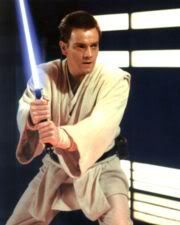 A young Obi-Wan Kenobi in the Ataru opening stance. Notes On Ataru:The name Ataru may be derived from the Japanese infinitive verb "Ataru," which has several meanings, including but not limited to "to be successful; to face (confront); to undertake; to treat; to be hit (passive voice)." The second definition, of "to face/confront" would be particularly in keeping with the form's characteristics.
|
|
|
|
Post by Ayin Tsade on Feb 23, 2009 18:28:30 GMT -4
Form V: Shien, also known as The Way of the Krayt Dragon, or The Perseverance Form, was the fifth of seven forms recognized as canon by the Jedi Council for lightsaber combat. It was developed by practitioners of Form III: Soresu, who felt that the defensively-minded form would unnecessarily extend time spent in combat by forcing its users to wait for an opportunity to strike, rather than creating their own openings. Shien is known for its unorthodox use of wide, sweeping strokes to strike down several enemies at a time. Djem So was initially considered a variation of this style, rather than a form of its own. Shien, considered the classical Form V, was more adept at blocking blaster bolts, whereas Djem So was designed primarily for lightsaber combat. Both Shien and Djem So were designed to use the opponent's attack against them, as evidenced by Shien's focus on returning blaster bolts to their origin. Under the New Jedi Order, Djem So is now listed as the sixth saber style, differentiating it from the Form V, Shien, for its differences in execution during lightsaber duels. "You will find it easier to deflect blaster fire with this form—and it shall also guard you against critical strikes by your opponents." ―Zez-Kai Ell "You will doubtless encounter many situations with multiple assailants. To better protect yourself from blaster fire without compromising your offensive capabilities, use the Shien form." ―Kavar Form V required a higher level of physical strength than the other lightsaber forms, due to its focus on complete domination of opponents. The form was developed alongside Form IV at a time when the Jedi were increasingly called upon to actively keep the peace. Some Jedi, noting its dedication to domination and strength, felt that Form V encouraged an inappropriate focus on controlling others. Others, including noted lightsaber combat instructor Cin Drallig, were cautiously neutral about the form. However, its proponents maintained that Form V was an effective and powerful tool for the Jedi Order. Shien was described as being well adapted to guarding against blaster fire and enemy strikes without compromising one's ability to launch powerful counterattacks, though was less effective against a single opponent. Shien was known to have existed at least as early as the Jedi Civil War. With its focus against blaster fire, Shien kept in mind that Jedi were often outnumbered by their opponents and needed to defend themselves while retaining offensive capability. The opening stance for Shien was a high guard position, with the hilt held in a two-handed grip above the user's head, and the blade angled upwards and behind the user. The dominant leg would be back, enabling powerful step-through strikes to be utilized. 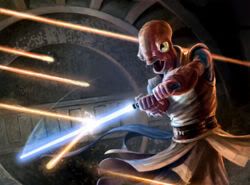 The Mon Calamari Jedi Rune utilizing Shien. Despite its metaphorical and literal strength, Form V was not without its weaknesses. Shien was particularly weak against a single opponent. However, a skilled duelist in Form V was capable of compensating for these weaknesses and employing the form effectively in combat. Variations
Backhanded grip: The variant form known as Shien is a rarely seen style that, while effective, was almost a topic of controversy among lightsaber masters due to the drastically different grip taught by practitioners of the form. The style calls for the Jedi to hold the lightsaber horizontally with the blade alongside the arm in a "reverse grip" style, using the lightsaber like a large dagger with the blade pointed "backwards" towards the "bottom" of their gripping hand. All strikes are made by sweeping the arm forward as though throwing a punch while whipping the blade forward away from the arm quickly in a broad arc. Adi Gallia was one of the few Jedi around the time of the Clone Wars known to actively practice the form, as was the Anzati Jedi Nikkos Tyris. Tyris favored a distinctive lightsaber style, in which the weapon was held with the blade pointing toward the ground by the strong side hand, with the off side hand riding loosely on the weapon's pommel. He moved the blade in a triangular pattern that effectively warded the lower two-thirds of his body from attack. With this unique style, he could deliver lightning-fast slashes and ripostes that could easily split an opponent from groin to neck, while also rapidly rotating upwards to block overhead strikes. Sith Shien: There was an ancient Sith variant of this classic lightsaber form called Sith Shien. Sith Shien was known to focus on quick and aggressive attacks against the user's opponent. This form uses fewer fluid movements than the normal Shien form and more staccato attacks, including sudden stabs at the enemy’s face, melee attacks and force powers with the nondominant hand. This is the form of Shien utilized by Galen Marek. Marek was also known to employ Juyo in his fighting technique. 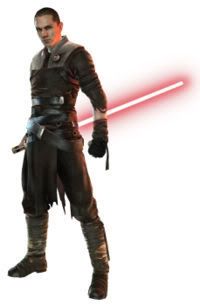 Notes on Shien and its variations compared to other forms: Notes on Shien and its variations compared to other forms:Many Jedi have noted the apparent similarities between Form V and Form VIII, known as Juyo. While the Sith styles of these forms are especially similar, there are key differences between the forms. Where as Shien involved blocking attacks with the goal of gaining the offensive, Juyo attempts to maintain a constant offensive for the duration of the battle. Also, Juyo is a powerful style for battling a single opponent, where as Shien (in all its variations) is designed to better combat groups. Shien is best described as “blocking with a strike,” meeting an opponent’s strike midstroke. In a lightsaber duel, a Shien user never exclusively defends or attacks, but skillfully weaves in motions that serve both functions simultaneously. Shien does not depend so much on physical strength, like Djem So, as much as it depends on fluidity and striking in multiple different directions in succession. Its fluid nature makes Shien adept at combating multiple opponents at once.
|
|
|
|
Post by Ayin Tsade on Feb 23, 2009 18:32:06 GMT -4
Form VI: Djem So, "Way of the Iron Grip""Form V's Djem So variation is devoted specifically to lightsaber dueling."―Cin Drallig "I prefer more straightforward tactics."
"Master of understatement." ―Anakin Skywalker and Obi-Wan Kenobi 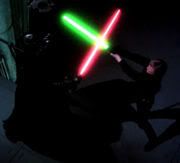 Luke Skywalker and Darth Vader utilizing Djem So against one another. Djem So was originally considered as a mere variation of Shien. However, it was later recognized as a legitimate and unique form, both because of its prominence during the Galactic Civil War and the early days of the New Jedi Order, and because of the differences between the two forms in style. While both styles emphasized moving in towards the opponent and turning defense into offense, Shien was primarily used against blaster fire, where as Djem So was solely a lightsaber dueling style. The form was given the name, “Way of the Iron Fist.” This described the fighting style’s philosophy of dominating and controlling combat. The name was also designed as a pun, referencing Darth Vader’s and Luke Skywalker’s mechanical hands; both were well-known users of the style. It is suspected that Ayin Tsade was the one to name the style. Utilizing a combination of blocks and parries, a Djem So user maintained a proper foundation in terms of defense against both ranged and melee attacks. While a Soresu user stayed on the defensive, however, and only counterattacked when necessary or when an opening appeared in his opponent's defense, a Djem So practitioner was not nearly so passive. Immediately after defending against an opponent's strike, a Djem So stylist would follow with an attack of his own, bringing the force of the opponent's own blow against them and seeking to dominate the duel. Djem So placed a heavy focus on brute strength and pure power, with wide, powerful strikes and parries followed immediately by counterattack. One of the characteristic moves of Djem So was an overhand power blow downward upon an opponent, the lightsaber held firmly in both hands. Unlike Soresu or Ataru, Djem So required the user to not only counterattack, but press the assault, combining Force-enhanced strength with powerful blade combinations to overpower and overwhelm an opponent's defenses. Djem So's sheer power, when combined with physical and Force-imbued strength, was capable of defeating a user of Makashi, a lightsaber form focused on dueling, finesse, and elegance, when employed by a skilled practitioner. 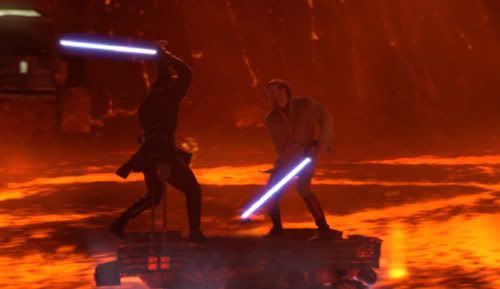 Darth Vader, attacking Obi-Wan with Djem So's signature two-handed overhead strike. Djem So allowed bulkier fighters to make good use of their own physical size and strength. It was for this reason that Sith blademaster Kas'im advised the fledgling Darth Bane to learn Djem So; Bane's imposing size and strength would serve to compliment Form V. Power attacks from a Djem So user could even knock an opponent back just through sheer kinetic force, throwing them off balance and leaving them vulnerable to further brute force strikes and power blows that sought not just to penetrate an opponent's defense, but push them back and leave them unable to counter blows. According to New Republic field reports, another potential practitioner of the Djem So style is Tiberian Coale’s Wookie apprentice, Argon. The Wookie employed powerful, overhanded blows in his duel against Jedi Master Ackbar on Reemin, as well as some acrobatic-type movements normally attributed to Ataru. Through sheer physical power, Argon shattered the Mon Calamari’s defenses and knocked Ackbar’s lightsaber from his grasp. Argon also held his lightsaber above his head at the Battle of Cathar, a stance recognized as a part of the Shien and Djem So styles, which his master is assumed to have taught him. However, Djem So was known for having a lack of mobility; it took careful thought and deliberation to make use of the full combat area with this form. Lightsabers belonging to Djem So practitioners sometimes had a solid casing (either as a whole or in multiple sections for maximum protection against power surge deterioration) and a heavily shrouded or beveled blade emitter. The beveled emitter was designed to designate separate facets of the blade for either offensive or defensive purposes. Their hilts also commonly included ridged, occasionally thick, hand grips, as Djem So required its users to maintain a solid grip on the lightsaber hilt. However, curve-hilted lightsabers could be used effectively by Form V practitioners, as demostrated by Darth Bane. Bane noted that curved lightsabers fit better into the palm, allowing greater power without costing precision. They also altered the angle of attacks ever so slightly, which gave Bane a unique dueling style, one that his opponents were not usually prepared to meet.  A typical design for a Form VI practitioner. "Peace through superior firepower." ―Jedi maxim on Forms V and VI
|
|
|
|
Post by Ayin Tsade on Feb 23, 2009 18:34:44 GMT -4
Form VII: Niman, also known as The Way of the Rancor, The Moderation Form, and The Diplomatic Form, was the sixth form of the seven original forms of lightsaber combat.
Under the New Jedi Order, Niman is now the seventh form. The Djem So variation of Shien was given its own place in the list of lightsaber combat forms, and was placed adjacent to Shien as a result of their similarities.
"For superior balance, use the Niman form. This form has no specific strengths, but no weaknesses either."
―Kavar
"Is Form VII the most worthy of study? No, but in general it is the most practical."
―Cin Drallig
Form VII attempted to balance all elements of lightsaber combat, combining the techniques from Forms that came before into a less intensely demanding combat style. In practice, Form VII was a combination of older forms (Forms I, III, IV, and V), and all of them in moderation. In the blending, much of the individuality was lost, but the strengths were spread evenly, and there was little weakness in it. Due to its "jack-of-all-trades" nature, the success of this form was largely dependent on the practitioner's intuition, improvisation, and creativity in combat rather than the rote responses derived from other forms. This broad generalization made Form VII well suited for diplomats, as they could spend their time training in the areas of politics and negotiation instead of combat training.
"The Jedi Council maintains that Form [VII] best suits the role of contemporary Jedi Knights. After all, a Jedi Knight who is overly trained in martial combat might be at a loss to resolve a complex political conflict or a sensitive trade disagreement."
―Cin Drallig
Niman was not a weak form. While most lightsaber forms bolstered the wielder's abilities in one area, while leaving him vulnerable in others, Niman was capable in all situations but had no dramatic strengths. It provided no edge in battle, but achieved its worth in not leaving its wielder as exposed as some of the more aggressive forms. Its strength was its balance. The form was also considered a basis for more 'unorthodox' fighting, as Jedi who used it were less frequently using automatic reflex than constantly thinking and often had time to invent unusual strategies for combat. It also provided a decent defense versus enemy Force powers and blaster fire.
Sometimes, sparring with another one could achieve a state of meditation, and the Niman form was one of the best such techniques. Its great strength was the way it allowed the Force to flow through its practitioner, revitalizing him even in the middle of combat. The philosophy of Form VII was "the leaf swept in the winds of the Force." Users of this lightsaber form achieved a mindset of one who was not troubled by their surroundings, but simply rode the current of the surrounding turmoil, being well-balanced within.
According to Cin Drallig, if a duelist dedicated himself exclusively to Form VII, he can expect to study the style for at least ten years before achieving mastery.
Known practitioners of the Niman form include Jedi Master Leddre'in Majernik, who once served the Order as a diplomat, and Jedi Counsel Member Tso Bajakian. Niman allowed Bajakian to focus less on lightsaber combat and intensify his study of the Force instead. The form fit Bajakian appropriately, as he saw the concept of lightsaber dueling as being “below” a Jedi of his stature.
|
|
|
|
Post by Ayin Tsade on Feb 23, 2009 18:37:24 GMT -4
Form VIII: Juyo, also known as The Way of the Vornskr, or The Ferocity Form, was the seventh of seven forms recognized as canon by the old Jedi Council for lightsaber combat. In use millennia prior to the Battle of Yavin, the Juyo incarnation of Form VIII was described as the most vicious form of lightsaber combat and was said to involve significant internal focus on the part of the user. Juyo had many users throughout the years, including Jedi Masters Kavar, Zez-Kai Ell, Vrook Lamar. As time passed, knowledge of Form VIII became restricted among the Jedi Order, who were worried that its precepts would lead practitioners toward the dark side. In contrast, members of the Sith, such as Darth Maul, employed Juyo without reservation, as did Dark Jedi such as Galen Marek. 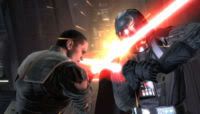 Galen Marek and Darth Vader, both using Juyo. Form VIII utilized bold, direct movements. According to accounts compiled by the New Jedi Order, it was more demanding in terms of energy used due to a broader focus and deeper utilization of emotion. A Form VIII practitioner was said to maintain a calm exterior appearance, but they were also stated to experience significant internal pressure, likened to a near-explosion, while using the form. It was also described as sometimes paradoxical and unpredictable, as well as filled with concepts that made the form too difficult to attract many students. "Predictably, he seeks to unbalance you with his erratic attacks. His technique is called Juyo, the most chaotic of the lightsaber forms. This form sacrifices much to bolster offense, leaving one exposed to attack by the Force." ―Kreia "Form [VIII], also called Juyo, is the most difficult and demanding of all the forms. Only high-level masters of multiple forms can achieve and control this discipline, which can lead to fantastic power and skill."―Cin Drallig on Juyo Juyo was described as the most vicious form of lightsaber combat, and was said to be filled with both fury and "malignant grace." It was also given the title of the most difficult and demanding form in all of saber combat. Skilled combatants with Juyo were said by Jedi Master Vrook Lamar to be able to "eviscerate a lone enemy." According to the Sith Lord Darth Traya, the form was both chaotic and erratic, with a heavy focus on offense. Jedi Battlemaster Cin Drallig listed bold, direct motions as characteristics of Juyo, qualifying them as more open and kinetic than Djem So, but with a less elaborate appearance than Ataru. Drallig contrasted the tactics of Juyo as not nearly as graceful or linked as those of Ataru, instead referring to them as "seemingly unconnected staccato sequences." He also listed one of the strengths of the form as its unpredictability. The form was said to require greater energy than Form V, due a broader wielding of a user's focus and a deeper emotional link. Despite the challenges inherent in the use of the form, it could serve as a pathway to significant power and skill. 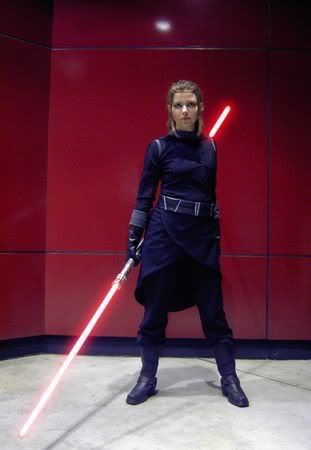 Jedi and Sith that displayed great skill in double-sided lightsabers tended to combine Shien and Juyo in their attack pattern. One of the most notable users of the style, Darth Maul, utilized the style while wielding a double-sided (or “rod-type”) lightsaber. Maul successfully combined the use of staccato attacks with a solid defense, while driving every movement to gain the offensive advantage. His Juyo style employed the use of butterfly kicks and other melee attacks as well as a solid use of Force powers. It is speculated that Maul derived some defensive techniques from the Jar’Kai style, as his defense with his double-sided lightsaber somewhat resembled the long-time Form XI technique of using one saber to block and another to attack. 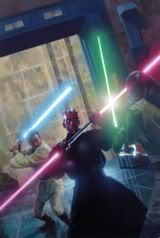 Darth Maul effectively controlling his duel with Obi-Wan and Qui-Gon through the use of Juyo.
|
|
|
|
Post by Ayin Tsade on Feb 23, 2009 18:42:41 GMT -4
Form IX: Vaapad - "Ferocity" or "Way of the Penumbra"In the latter days of the Old Republic, a new variation of Form VIII, dubbed Vaapad after a creature native to the planet Sarapin, was created by Jedi Masters Mace Windu and Sora Bulq. Vaapad was explained as being a state of mind rather than just a fighting style, allowing the wielder to channel his own inner darkness into the duel, and accepting the fury of the opponent. Windu, Bulq, and also Windu's Padawan Depa Billaba were three notable practitioners of the Vaapad variant, though records of both Juyo and Vaapad survived the Great Jedi Purge and were recovered by the New Jedi Order, who preserved knowledge of the form into the Sith-Imperial War. Once considered a substyle of Juyo, Vaapad is now recognized as a different and unique fighting form, particularly because it requires the user to give oneself over to the Force entirely. Vaapad was more than a fighting style; it was a state of mind that led through the “penumbra of the dark side,” requiring the user to enjoy the fight, and relish the satisfaction of winning. The practitioner of Vaapad would also accept the fury of their opponent, transforming them into one half of a superconducting loop, with the other half being the power of darkness inherent in the opponent. The form was also mentioned with a cautionary warning by the Jedi that use of Vaapad led the user perilously close to the dark side due to its focus on physical combat. Vaapad was required a constant and sizable stream of Force use from the user, with a barely contained explosion of Force power inherent within the user, which required considerable control over in order to restrain. The form's appeared to be unconnected, its motions seemingly unpolished to an untrained observer. "I created Vaapad to answer my weakness: it channels my own darkness into a weapon of the light."―Mace Windu to Obi-Wan Kenobi "Six there were for generations of Jedi. The seventh, is not well-known. Powerful form it is. Deadliest of all. But dangerous it is, for its master as well as its opponent. Few have studied. One student alone, to mastery has risen." ―Yoda "This is called Vaapad, Kar. How many arms do you see?" ―Mace Windu facing Kar Vastor in unarmed combat on Haruun Kal 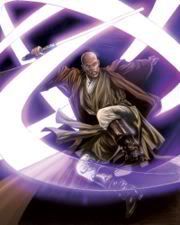 Mace Windu's Vaapad specialized in delivering flurries of attacks. Jedi Master Mace Windu developed Vaapad drawing on the movements of the creature bearing the same name from the planet Sarapin for inspiration. Vaapad used quick and deadly strikes to overcome the enemy, with the user appearing to wield many lightsabers at once, moving too fast to see, just as the vaapad creature would attack with blindingly fast tentacles that were impossible to count until the vaapad had died. While using Vaapad, the user's attacks would flow into each other with liquid precision, creating the constant near-invisible weave of energy which was the ready-stance of Vaapad. It was also possible to apply Vaapad to unarmed combat, with the user's arms becoming too fast to see, as well as to the use of dual lightsabers. While observing the duel between Darth Sidious and Mace Windu, Anakin Skywalker considered the Windu's Vaapad bladework to be "an oblate sphere of purple fire" which contained dozens of blades attacking from every angle.  Mace Windu and Sora Bulq, the two creators of Vaapad, duel each other on Ruul. Weequay Jedi Master Sora Bulq, already considered one of the Jedi Order's finest lightsaber practitioners and skilled in all seven original forms, helped Mace Windu perfect Vaapad, creating the form described as both incredibly intense and dangerous. Darth Tyranus described the power of Vaapad as skirting the dark side of the Force, but said in a duel with Weequay Jedi Sora Bulq that the form was bridled and weaker without use of the dark side. After the Battle of Geonosis, Bulq became disillusioned with the Republic and the Jedi Order and fell to the dark side through the influence of Darth Tyranus. After his fall, Bulq claimed that he had perfected the form, a claim which Windu disputed while engaging Bulq in a lightsaber duel. While Bulq had previously practiced Vaapad with Windu, he was unable to defeat him in combat, though neither did Windu defeat Bulq. As was later said by Windu, Bulq did not master Vaapad; Vaapad mastered him. Jedi Master Mace Windu, who developed Vaapad along with Weequay Jedi Sora Bulq stated that Vaapad was an answer for his own weakness, allowing him to channel his own internal darkness into something positive. He also said that he would not allow the use of the form without his permission, something that he had only given to his apprentice, Depa Billaba. Jedi Master Siri Tachi once explained to her Padawan, Ferus Olin, that the reason Mace Windu was able to dismiss the pleasure in power which Vaapad brought was by acknowledging it and being constantly aware of it. Windu employed the form in numerous battles, including in the Petranaki Arena against bounty hunter Jango Fett, where his relentless use of Vaapad overpowered Fett. In his final duel against Darth Sidious in 19 BBY, Windu gave himself over completely to Vaapad after his three Jedi companions were quickly slain by the Sith Lord. He allowed it to fully channel his own inner darkness and accepted and used the darkness of Sidious as well. When fully immersed in his form, Windu's fighting prowess was to the level where he could allow his body to fight automatically for him without needing to direct it with his mind. Sidious' own fury was used and redirected by Windu via the use of Vaapad, a process which Windu mentally likened to a lightsaber deflecting a blaster bolt back at its source. After Windu disarmed Sidious, the Sith Lord attempted to blast him with Force Lightning, but Windu responded by once more employing Vaapad techniques to channel the dark power of the lightning through him without it affecting him; he then redirected it back to its source. However, Windu also believed that his use of Vaapad alone was insufficient to defeat Sidious, as he felt it would only result in a stalemate. "Form [IX] is very aggressive, Quin. It can take the user very close to the dark side—and you, frankly, sometimes walk too close there as it is."―Mace Windu Other notable users include the Sith Lord Tiberian Coale and Li-An Jinn, who was the only other person Mace Windu taught Vaapad to apart from Depa.
|
|
|
|
Post by Ayin Tsade on Feb 23, 2009 18:44:44 GMT -4
Form X: Sokan "Cruelty" or "Way of Awareness"Sokan is commonly known as “using terrain to one's advantage.”  Obi-Wan Kenobi, utilizing Sokan, gains the high ground over Darth Vader on Mustafar. "It's over, Anakin. I have the high ground!" ―Obi-Wan Kenobi to Darth Vader Sokan was more of a principle of lightsaber combat than a true form. Developed by the ancient Jedi Knights during the Great Hyperspace War, Sokan teaching revolved around using the environment itself to gain a tactical advantage in combat. Sokan involved maneuvering so that swift strokes of the lightsaber could be aimed towards the opponent's vital areas, using quick tumbles, jumps, and movements. Combatants made use of large amounts of terrain, trying to maneuver their opponents into vulnerable areas during the course of battles that involved Sokan techniques. This technique allowed for great speed and mobility and left no openings in one's defense. Prior to the Clone Wars, Sokan practitioners integrated highly kinetic elements of Ataru with their ancient Sokan techniques to create a blend of styles that relied upon agility. Jedi Master Ayin Tsade is known to make full use of his surroundings. Ayin insists on fighting on a three-dimensional axis, and is known to frequently make use of walls, pillars and other objects to outmaneuver, evade, and advance on his opponents. He is also capable of utilizing any of the other fighting styles while standing still on the side of a vertical wall. In this way, Ayin has developed Sokan to the point that it is considered an official lightsaber form. Ayin displayed his prowess in the Sokan form during his battle with Tiberian at Coruscant During their first encounter, Ayin kicked his opponent towards the wall of the Jedi Temple Archives before landing on the wall himself. Standing on the wall’s surface, Ayin stabbed “downward” at the Sith Lord’s head, who narrowly evaded the killing stroke. Ayin also employed Sokan at Mindar, running up the side of a building while Tiberian crushed the platform through the Force.
|
|
|
|
Post by Ayin Tsade on Feb 23, 2009 18:48:39 GMT -4
Form XI: Jar’Kai "Duality" or "Way of the Twin Blades"Jar'Kai was a once considered a subform of lightsaber forms Ataru and Niman, and was one of the oldest forms of lightsaber combat, a dual blade wielding technique. The usage of the Jar'Kai form actually predated the invention of the lightsaber. Largely as a result to the popularity of Jedi and Sith wielding twin lightsabers during the early days of the New Republic, Jar’Kai is now accepted as an official fighting form. "Perhaps you would like to learn something before you die. The use of two blades, one to support the other, can be traced back thousands of years and was common to both of our species. The invention of lightsabers has done nothing to lessen the effectiveness of this strategy—as you are about to learn." ―Boc Aseca to Kyle Katarn 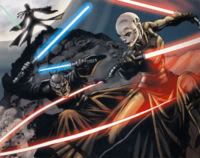 Sora Bulq and Asajj Ventress use Jar'Kai against one another.  Anakin Skywalker using Jar'Kai. A combatant could maintain a strong offense using the Jar'Kai tactic, since two blades could keep an opponent wondering which one to shift towards to defend against. One of the blades in the wielder's hands was used for attacking while the other one could be used for defending, such as parrying, The other blade could also be used for more offensive purposes. The tactic is also useful against more then one opponent as one blade could only be in one place at one time. However, the Jar'Kai tactic is not without its weaknesses. A user of Jar'Kai who lost the offensive was at a disadvantage to a single hilt user, especially a powerful one. The use of two blades prevents the user from putting all his weight behind a defensive block, thus weakening one's defense considerably. A physically stronger opponent could simply batter a Jar'Kai user until their guard finally gave way. With two single blades, it is also harder to control as the non-dominant and dominant hands have to be used in unison. If not careful or trained properly the use of two lightsabers would only hinder the user's performance. The application of Jar'Kai also existed as a tactic instead of a completely independent style; one example included Sora Bulq, who utilized Jar'Kai in conjunction with Vaapad. Also, Anakin Skywalker's Jar'Kai application against Count Dooku on Geonosis was actually based on Ataru swordplay. Unfortunately, as Skywalker had not received advanced training in either the Jar'Kai or Form IV, Dooku was easily able to break through Anakin's array of weapons.  The legendary Darth Revan wielding dual lightsabers. Some Jar’Kai specialists employed a shoto (sometimes simply called short lightsaber) in their non-dominant hand. The short blade proved excellent for blocking while allowing the primary lightsaber for a return strike. Masters of this technique could deliver a high number of attacks in a very short time, potentially overpowering opponents quickly rather than engaging in a protracted duel. Notable examples of this use include Darth Revan and Luke Skywalker, the Grand Master of the New Jedi Order, who displayed his skill with the dual-bladed tactic during the Yuuzhan Vong War, often utilizing it with a shoto in conjunction with his regular lightsaber. Regardless of receiving formal Jar'Kai training or not, Luke proved to be one of the best dual-blade duelists in his era. During the Swarm War, the Sith Master Lomi Plo used Jar'Kai against Skywalker when she dueled him two out of three times, using a standard lightsaber in conjunction with a shoto. Swil Kit Fisto and Ayin Tsade both possess a red shoto with which to perform this style of combat. Ayin also uses his shoto to block or to whirl around as a part of his Form XII vortex. 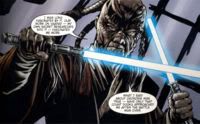 Sora Bulq using Jar'Kai with a shoto. 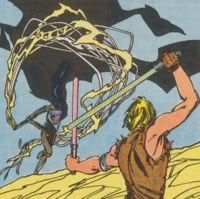 Luke Skywalker blocking a lightwhip with a shoto. Many Jedi Knights and Sith Lords trained to use Form XI in the hopes of gaining a basic knowledge of the dual-bladed attack, but very few ever achieved complete mastery of Jar’Kai. Jacen Darxtryder proved he had gained much skill in the use of this form during his training session with his master in Coruscant. Jacen threw one of his lightsabers in an arc-shaped trajectory while rebounding off of a wall and attacking Ayin from the other side. After he regained his thrown saber, Jacen slashed at his master in a cross-crossed fashion, which Ayin narrowly blocked before declaring that their training session had ended.
|
|
|
|
Post by Ayin Tsade on Feb 23, 2009 18:49:41 GMT -4
Form XII: Veros - “Fluidity” or “Way of the Vortex”
[Information to come.]
|
|
|
|
Post by Ayin Tsade on Feb 23, 2009 18:50:19 GMT -4
Form XIII: Torr’en Sho - ‘Versatility” or “Way of the Maverick” (gun and saber)
[Information to come.]
|
|
|
|
Post by Ayin Tsade on Feb 23, 2009 18:51:51 GMT -4
Alternate styles:
Saber barrier was a defensive telekinetic lightsaber combat technique. Designed for dual saber combat, it created a barrier of lightsaber blades by having the lightsabers spin around the saber-wielding Jedi. Kreia used this power against the Jedi Exile in the Trayus Academy on Malachor V, and the Dark Jedi Alora may have used it years later against Jaden Korr. Mace Windu also mastered this technique. [The basis of Ayin’s more advanced Form XII]
Saber throw
Saber throw was an offensive usage of the lightsaber, combining Force Push and Force Pull allowing the Jedi to throw their lightsaber at targets in a boomerang-like fashion. It was a common Force power, as it was a good long range alternative to the typical short range lightsaber attacks. Darth Vader used the saber throw against Luke Skywalker in their fight on the second Death Star. Since lightsabers switch off when they leave their owners hand, the thrown lightsaber needed to be telekinetically kept on, however, some lightsabers had a special "blade lock" feature.
Spinning attack
The spinning attack technique was a trispzest-based technique, mastered by Maw. It consisted in the trispzest-user spinning wildly in the air while lashing out to all sides with the lightsaber, and was highly effective against multiple opponents. Jedi Grandmaster Yoda used it against Darth Tyranus during their duel on Geonosis. Yoda once again used this technique to battle Darth Sidious in the Senate chamber on Coruscant, though the skills of the Emperor as a duelist were too great to be overcome by this magnificent move.
Short lightsabers:
The shoto (sometimes simply called short lightsaber) was a lightsaber with a shorter hilt that produced a drastically shorter blade than its more common counterparts. Relatively rare in comparison to ordinary lightsaber types, shotos were sometimes used in the off-hand of a Jedi or Sith duelist.
Essentially the purpose of a shoto in lightsaber combat was to counter attacks by an opponent's weapon while freeing the primary lightsaber for a return strike. To this end, shoto wielders were required to become proficient in the lightsaber techniques of Niman or Jar'Kai in order to reduce risk of injury to themselves due to the increased dexterity needed to master the use of both blades simultaneously. Masters of this technique could deliver a high number of attacks in a very short time, potentially overpowering opponents quickly rather than engaging in a protracted duel. Shotos were also used to counter lightwhips.
Other than blade and hilt length, the shoto was little different from a normal lightsaber; it utilized the same types and number of crystals, could be upgraded with different parts, and took the same Force-sensitivity to construct.
Shōtō is also a Japanese term used for swords between 1-2 shaku (roughly 30-60 cm) in length. Samurai often wielded short swords such as shoto in their off-hand, keeping up the comparisons between Jedi and samurai.
|
|



